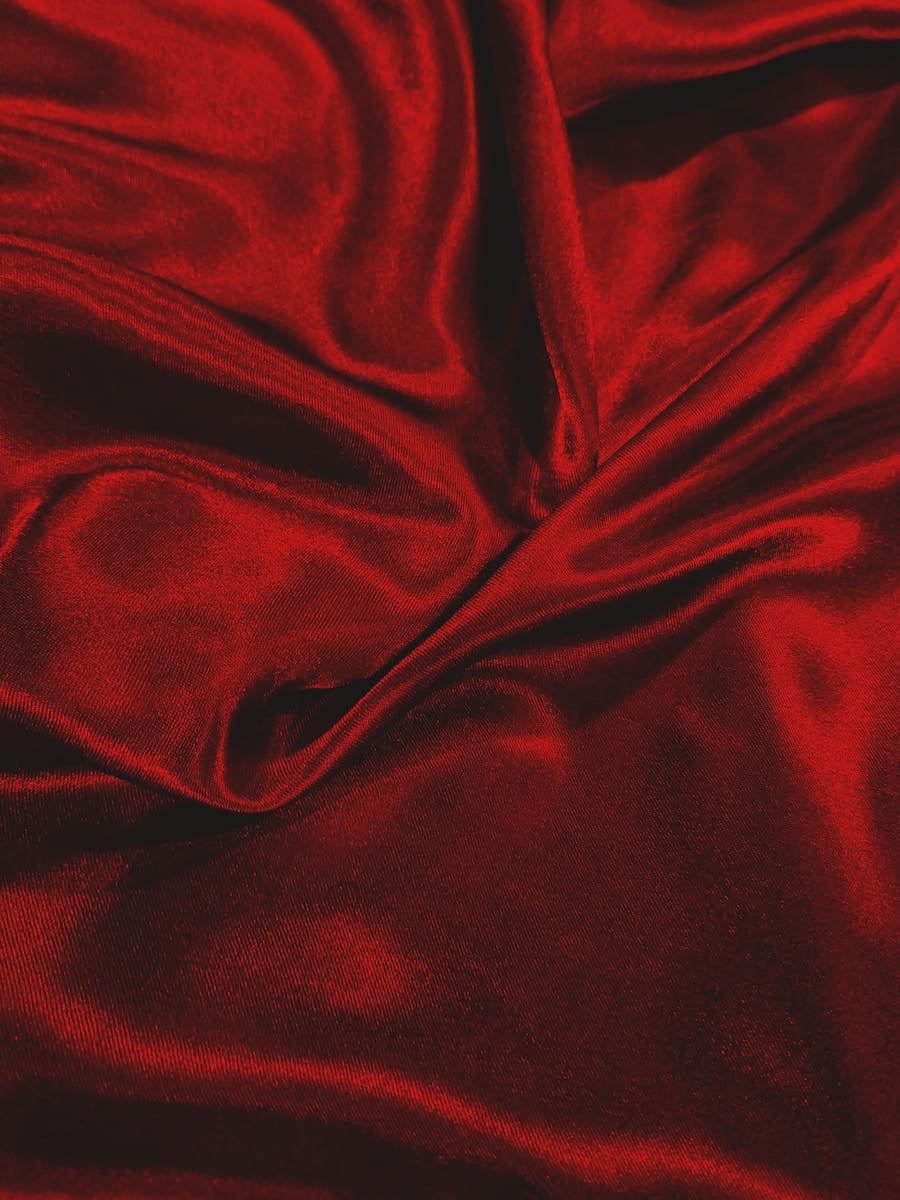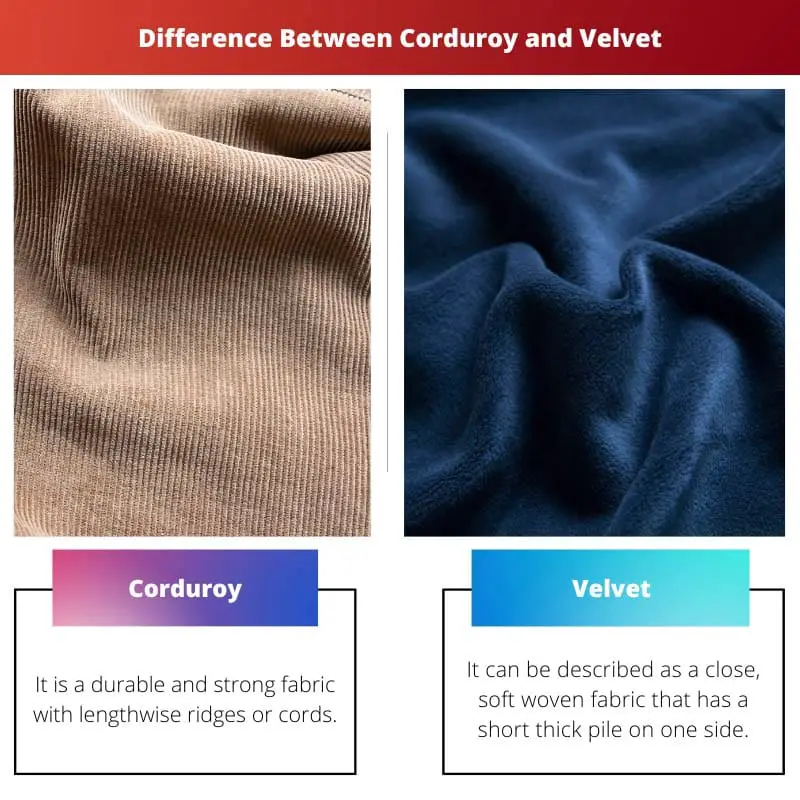In terms of fashion, many of us are concerned with it because it defines our looks. The contribution of how the clothing comes out is directly linked to the kind of fabric mainly used to make what we put on.
In the market, people use many fabrics to make clothing.
Many of them comprise corduroy velvet, wool, nylon, and cotton. Corduroy and velvet are two which comprise more similarities and have been referred to interchangeably. In this article, the chief aim is to differentiate corduroy and velvet.
Key Takeaways
- Corduroy is a durable, ridged fabric made of twisted fibers, while velvet is a soft, plush material with a dense, even pile.
- Corduroy is characterized by its distinct vertical rows or “wales,” whereas velvet has a smooth, uniform surface.
- Corduroy is used for casual clothing and upholstery, while velvet is considered a luxury fabric for formal attire, curtains, and upholstery.
Corduroy vs Velvet
Corduroy features parallel, raised ribs (wales) on its surface, providing a unique look and feel. It is durable and casual, making it a popular choice for pants, jackets, and upholstery. Velvet, characterized by its soft, plush texture and elegant sheen, is more luxurious than corduroy. Crafted from various fibres, velvet is used in high-end clothing, accessories, and home furnishings, exuding a sense of sophistication and refinement.

Corduroy is a ridged and durable fabric that textile producers can manufacture with a range of distinctive materials. It is notable for its unique pattern, which can be weaved in a wide variety.
It can be woven with cotton and polyester blend or even full polyester.
In textiles, velvet is a fabric with dense and short piles used in upholstery and clothing. It is manufactured in a pile weave of synthetic, cotton, or silk fibres and is characterized by a soft down surface formed by clipped yarns.
The fabric’s wrong side is shown, and a smooth weave is employed.
Comparison Table
| Parameters of Comparison | Corduroy | Velvet |
|---|---|---|
| Interpretation | It is a durable and strong fabric with lengthwise ridges or cords. | It can be described as a close, soft woven fabric that has a short thick pile on one side. |
| Origin | Dates back to ancient Egypt | Dates back to China |
| Nature | Not as dressy as velvet | Appears dressier and also more luxurious |
| Weight | More lightweight | Comparatively heavier |
| Durability | Tends to be more durable and stronger | Not as durable |
What is Corduroy?
Corduroy is a textile with a unique texture like a wrist wale and cord. Modern corduroy is composed of tufted cords and sometimes exhibits a channel between the tufts.
Sometimes textile producers make corduroy with wool, while the ridges present on corduroy’s wool are not as visible as ridges on corduroy.
The dyed corduroy can be in a wide distinctive color range done by fabric manufacturers. Meanwhile, one corduroy’s form dying leads to an uneven fading that is aesthetically pleasing.
Corduroy comprises three distinctive yarns woven together. The chief two yarns create a twill or plain weave.
But the third yard into this weave intersperses in the filling direction and forms floats that pass over approx four warp yarns. Then textile producers use blades to serve the float yarns and cause piled fabric’s ridges to appear on the weave’s surface.
Garment manufacturers used corduroy in the past to make everything from soldiers’ uniforms and workwear to upholstery and hats. These days, chiefly garment manufacturers use to make it jackets, pants, and overall.
Corduroy trousers enjoyed cult-like popularity in the 1970s, but now they lost it.

What is Velvet?
Velvet is a woven, tufted fabric in which the cut threads are distributed evenly with a short, dense pile, giving it a soft feel and distinctive way. In the past, it was manufactured from silk.
It can be manufactured from liner, synthetic, wool, and cotton fibres.
On a special loom, the velvet is woven that weaves two material’s thicknesses at the same time. Then two pieces are cut apart for pile effect creation and the two fabric’s lengths are wound on distinctive take-up rolls.
Due to the pile, velvet is difficult to clean.
Meanwhile, modern dry cleaning methods aid cleaning more place feasible. The pile of velvet is created by vertical or warp yarns, and through fill or weft yarns, the velveteen pile is created.
It can be manufactured from several distinctive fibres kind, traditionally, it was silk.
Today, much of the velvet sold, namely, silk velvet, is a mix of silk and rayon. It is rare to manufacture velvet made entirely from silk. To make velvet, cotton is also used though this leads to the fabric as less luxurious.

Main Differences Between Corduroy and Velvet
- The origin of the word corduroy is traced from two English words, namely cord (ribbed fabric) and Duroy, which in the late 18th century was termed as corduroy. Meanwhile, the origin of the word velvet is traced from an old French word, namely, velvotte.
- There are a total of six kinds of corduroy in the market, namely, standard corduroy, pinwale corduroy, elephant corduroy, Bedford corduroy, spandex corduroy, and pigment-dyed corduroy. In contrast, panne velvet, crushed velvet, stretch velvet, embossed velvet, pile on pile velvet, cisele velvet, and plain velvet are some of the types of velvet.
- Corduroy is mainly used for coats, slacks, breeches, hunting apparel, trousers, millinery, and jackets. On the other hand, velvet is chiefly used in bathrobes, upholstery, bedding, eveningwear, wall hangings, hats, and many more.
- The care tips comprise for corduroy are to choose a gentle cycle and wash in cold water if the corduroy is dark and wash in warm water if the corduroy is pastel. On the flip side, never iron, don’t blot spill when wet, don’t apply pressure, and hang in a well-ventilated area are some of the velvet care tips.
- Corduroy is manufactured from any of the textile fibres in a major amount, with two fillings and one wrap. On the contrary, the production of velvet is done on a double cloth which is a special loom and produces two velvet pieces simultaneously.

References
- https://books.google.com/books?hl=en&lr=&id=hdeOjr5JZ-cC&oi=fnd&pg=PT8&dq=corduroy&ots=lpFBFUvqVL&sig=SbXZ_sUycZrsleTgkPhTYbvUVzM
- https://www.degruyter.com/document/doi/10.1525/9780520337794/html
